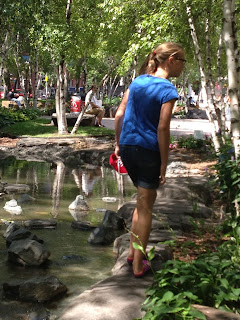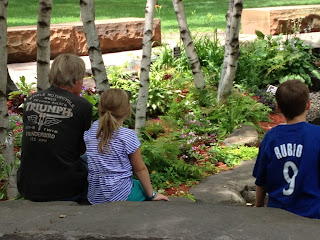 |
| Minnesota History Center's Then Now Wow |
 |
| DiMenna Children's History Museum |
Children have generally been underserved in history museums. Typically they do not even rise to the level of a secondary audience; only sometimes are they served in monthly programs or a hands-on history alcove. While history museums have not valued children as an audience group, children’s museums haven’t regarded history as an area for children to explore. Outside of an antique car to climb on or grandmother’s attic full of clothes for dress up, children’s museums have taken a pass on the past. Even though they haven’t focused on connecting children to the past, children’s museums have brought an understanding of development together with an experienced-based approach in museum settings to create interactive experiences and environments across a wide range of topics, including culture, as complex and abstract as history.
Change is afoot. Children
are gradually being recognized as an important opportunity for history museums
to broaden their public engagement using objects, stories, and environments to look
back and consider change over time. With this recognition, history museums are
finding ways to allocate space, involve children in planning, write labels for
them, and genuinely welcome them.
First came Sensing Chicago, a children’s gallery at the Chicago History Museum
that opened in 2006. Connecting Kids to History with Museum Exhibitions,
a book of essays on children and history exhibitions from a variety of
perspectives followed in 2010. More recently, two history exhibitions for
children have debuted, one at the New-York Historical Society Museum and Library and one at Minnesota History Center
in St. Paul.
- DiMenna Children’s History Museum (DCHM) opened within the New-York Historic Society (NYHS) in November 2011. Geared to 8-14 year-olds and targeted to fourth graders, it is located on the lower level of NYHS sharing 4,000 square feet with the Barbara K. Lipman Children’s History Library. Eleven interactive pavilions invite children to, “Explore 300 years of New York and American history through the eyes of children of the past.
- A year later, in November 2012, Minnesota History Center (MHC) (St. Paul) opened Then Now Wow (TNW). Designed for school-aged children, MHC also promotes the exhibition as, “…perfect for everyone who wants to learn more about Minnesota.” To share wow moments that shaped the State of Minnesota, the exhibition fills 14,000 square feet, the largest exhibit MHC has ever launched.
Organizational
Direction
While sharing a school-age
audience and holding to strong and deliberate efforts to engage children in
exploring the past, each exhibition takes directional cues from its host
institution. This institutional context influences
each exhibition and sometimes plays out in noteworthy ways for children.
(For convenience, both Then Now Wow and DiMenna Children's History Museum will be referred to as exhibitions.)
 |
| A statewide context |
As a city history museum, NYHS’s exhibition uses the city as the context, following the stories of children across time periods, social issues, and key moments in the City’s and the nation’s history. As a state history museum, MHC draws on the state’s geography as a backdrop for sharing stories, memories, and a sense of place across time.
Contextual factors have implications
for the exhibitions’ conceptual and physical dimensions. History unfolding
across a physically large and geographically diverse state with 5 million inhabitants
is a story told more expansively than covering a city (even with 8 million
residents), especially when space is available. At 14,000 square feet, Minnesota’s
state history exhibition is much like its wide-open spaces and sprawling
suburbs. NYHS’s 4,000 square foot city history museum (including a library) is
as compact and efficient as the high-density living of its surrounding city. Nevertheless,
dedicating so much space to children in its recent renovation was a bold move
for NYHS.
 |
| Meet the young Alexander Hamilton (DCHM) |
Focus on Children
Both exhibitions focus on a primary audience of school-aged,
although they approach and work with it in different ways. DCHM is a child-centered exhibition with a clear
school-age focus. It tells stories of the extraordinary lives of six New York children
from the past: an Hispanic baseball player, a Dutch immigrant, an African-American
student who became a doctor; Alexander Hamilton; an orphan train girl; and the
young “newsies” who sold papers. This approach works to connect children today
and what they do–go to school, play sports–with children from New York’s past
whose enterprise and creativity affected the course of history. By identifying with and learning about children from different times in New York's and America's past, children explore time periods from 1692 to 1932, connect with key moments, and forge their own connections to the past.
 |
| Connecting with children today and their interests (DHM) |
While not explicitly child
centered, TNW is a child-friendly history exhibition for the general public. Four
regions that blend place and time and recognize ethnic diversity organize the
exhibition. North Woods, Dakota Homelands, Grasslands to Cropland, and Cities
and Suburbs are areas recognizable to most Minnesota children. Stories
and memories of people and places weave together across these landscapes and
Babe the Blue Ox Pavilion (theater) to engage children in exploring and
understanding the past. Moving through the North Woods, for instance, children
meet and join the miners who work in the ore mines. They join students who have
attended the Pipe Stone Boarding School and prepare to portage around the falls
at Grand Portage. In spite of being conceptually more focused on geography than
on children, TNW has a well-tuned sense of what fascinates children: setting
dynamite in the Iron Range mine, dressing a bison, or stealing away on a boxcar.
Engaging
Experience with History Concepts
 |
| Pushing and pulling the plow (TNW) |
DCHM incorporated artifacts, photographs, props, and maps into interactives, flip doors, games, video, kiosks, and scenic elements to encourage children to identify with the six historic characters. A child can look at coins from
1919 and 1823 under a magnifier, practice cross stitch, vote, and touch items
like those found in a 17th century home. Video kiosks, digital media
and games are well used in every area. Digital media allows a child to read and
decode the first issue of the Federalist Papers, pick a location to sell
newspapers on a touch screen, practice penmanship, and follow Alexander Hamilton
in creating a national banking system.
 |
| Riding the orphan train (DCHM) |
 |
| The fur trade, as told by the beaver (TNW) |
TNW encourages historical imagination by engaging perspectives and a combination of multi-sensory and full body experience. Visitors, often school groups, gather on a small (3’x5’) carpet that simulates the elevator miners packed into to descend deep into the mine shaft; they tour the ore mine with helmets outfitted with headlamps; they can become a driller or a blaster. Old and young take a seat at an old-fashioned desk in front of the class picture at the Pipestone Boarding School. Sometimes perspectives interact with each other. The result can be humorous in learning about the fur trade from the perspective of fur traders and from the fur trade’s main commodity, the beaver. One can be the farmer working the plow and then the ox pulling it.
Then-now, perspective taking that connects the past and present, plays out in both exhibitions. Explicit in its title, TNW draws the connection in a various ways: immigrants from the 1870’s and the 1990’s, a modern tipi, or “Timberjack Harvesting” now. The historical viewfinder pavilion in DCHM offers then-now views of buildings and street scenes including Broadway and 32nd Street in 1902 and today.
Design
Challenge
Regardless of size, exhibitions–perhaps history exhibitions
for children especially–find design a challenge. History doesn’t come in small, concrete packets.
Time is fluid and stretches, as does geography. There are countless stories to
tell. Brief or long, a label tells little (especially to non-readers, new
readers, or slow readers) compared to visually comparing the stack of beaver,
mink, or otter pelts or striding across a floor map of New York City. The more
the experience releases the message, the less a label is needed.
 |
| Reading about the newsie's (DCHM) |
Perhaps recognizing the
school-age audience, both exhibitions have avoided the primary palette that is
often the default in designing for children. Both exhibitions incorporate iconic
elements; an icon’s familiarity can draw children’s attention and facilitate
intuitive navigation of a space or topic. With its sod house, canoe, tipi, and
boxcar, TNW relies on authentic and full-scale icons and generally does so in
ways that spark imaginations and engage children in physical activity. In DCHM,
icons are both physical, like the orphan train car, and also personalities, like
Alexander Hamilton. Precious space makes this practical, but scenic elements in
a limited material palette feel more theatrical than historic.
 |
| Dressing the bison in the wide open (gallery) spaces (TNW) |
In both Then Now Wow and
DiMenna Children’s History Museum, children are solidly at the center of conceptual
organization, experience development, and design. As a pair, they illustrate
interesting variations in connecting children to the past. How will these
exhibitions influence history exhibitions for children currently in the
pipeline and those just now taking shape in a team’s discussions? Time will
tell. And this will be a story worth following.










